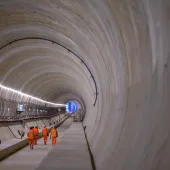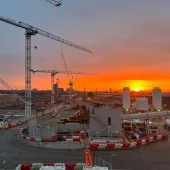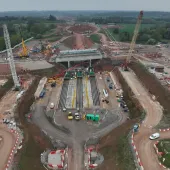Video: UK-first for HS2's River Tame West viaducts
New technique used in the UK for the first time completes first section of HS2's River Tame West viaducts
A new construction technique, being used in the UK for the first time, has successfully completed the first section of HS2's River Tame West Viaducts, which will span 472m.
The specialist method will be employed to build nine viaducts in HS2’s Delta Junction, covering a total of 6,500m.
The method involves installing pre-cast concrete segments produced at HS2's factory nearby, where a team of 200 workers recently celebrated production of the first 1,000 segments.
Now, for the first time in the UK, HS2 have used a cantilever process to build the initial span of a single-track viaduct in the West Midlands. The River Tame West Viaducts, consisting of one single-track and one double-track viaduct, are situated at the northern end of the Delta Junction, which allows trains to travel between London, Birmingham, and the north.
These viaducts cross the River Tame near Water Orton and connect to the Curdworth Box, which will carry high-speed trains over the existing Birmingham to Derby railway.
Construction of the 20 supporting piers began in 2023, and the first spans of the three-track section were completed in spring 2024. This phase involved placing the segments on two 42m-long truss beams, moving them into place with a skidding trolley, and securing them using post-tensioning techniques.
Since then, a giant cantilever structure has been constructed, featuring a 22m-high mast with temporary post-tensioning cable stays and a 14m-high swivel crane. The crane installs one concrete segment at a time, completing each 45m span. The permanent post-tensioning tendons are then stressed, allowing the temporary cable stays to be removed, leaving the permanent structure in place. This process is repeated between each pier until all spans are complete.
Developed by Campenon Bernard, now part of VINCI Construction, the mast and swivel crane used for the River Tame West Viaducts were designed and manufactured by BERD. A team of 40 people is currently involved in the operation, moving a total of 2,500 concrete segments into place. All deck segments are expected to be in place by August 2026. The same technique will be used to construct nine viaducts in the Delta Junction.
The concrete segments are made at HS2's dedicated factory near Lea Marston, where a 200-strong team recently celebrated producing the 1,000th segment out of a total of 2,742 for the Delta Junction’s six segmental viaducts.
Sam Hinkley, HS2’s lead senior project manager for Delta Junction, said: “This is a fantastic UK-first for HS2, signifying another proud moment for everyone working on the project. It has only been possible through the collaborative and innovative approach with our designers, civils contractor, and wider supply chain, who are delivering this huge feat of engineering.”
The project is being delivered by HS2’s main works contractor for the West Midlands, Balfour Beatty VINCI (BBV), which is constructing 90 km of HS2 between Long Itchington in Warwickshire and Staffordshire via Birmingham.
Nicolas Gallone from Balfour Beatty VINCI added, “We’re using a specialist construction method to build the River Tame West Viaducts – a technique which has never been used in the UK before. It’s a significant moment for Balfour Beatty VINCI, the HS2 project, and the construction industry in this country. This post-tensioning technology, pioneered by VINCI, is used on other major construction projects around the world. Now, it’s helping us to deliver these complex viaducts and overcome engineering challenges along the way, including existing waterways and utilities.”
The viaduct design is being managed by a joint venture between Mott MacDonald and SYSTRA (MMSDJV). Ian Johnson, project director at MMSDJV, stated: “Reaching this incredible milestone is a wonderful moment for the Mott MacDonald SYSTRA Design Joint Venture team. It brings to life the innovation, collaboration, and commitment of everyone involved on the project and marks a significant part of the journey to bring high-speed trains between Birmingham and London.”
In the complex Delta Junction, six railway tracks run alongside each other, connecting to the southern end of the Curdworth Box. The River Tame West Viaducts carry three tracks, the River Tame East Viaduct carries one track, and the Water Orton Viaducts carry two tracks.
HS2’s Delta Junction is a triangular section of line, allowing trains to travel between London and Birmingham, Birmingham and Manchester, and directly between London and Manchester without stopping at Birmingham. It comprises embankments, cuttings, and a total of 13 viaducts taking high-speed tracks over motorways, local roads, existing rail lines, rivers, and floodplains. These include six pre-cast segmental viaducts, four composite viaducts, and three low viaducts.
Once completed, HS2 services will run between London and the West Midlands on a dedicated high-speed line before reaching destinations further north via the existing West Coast Main Line. This will provide significantly more efficient and faster journeys, while relieving pressure on the congested southern end of the West Coast Main Line, allowing more local and freight trains to operate.







